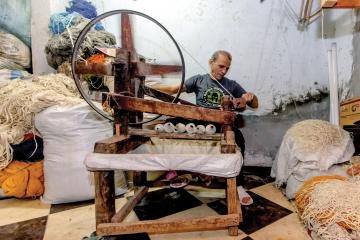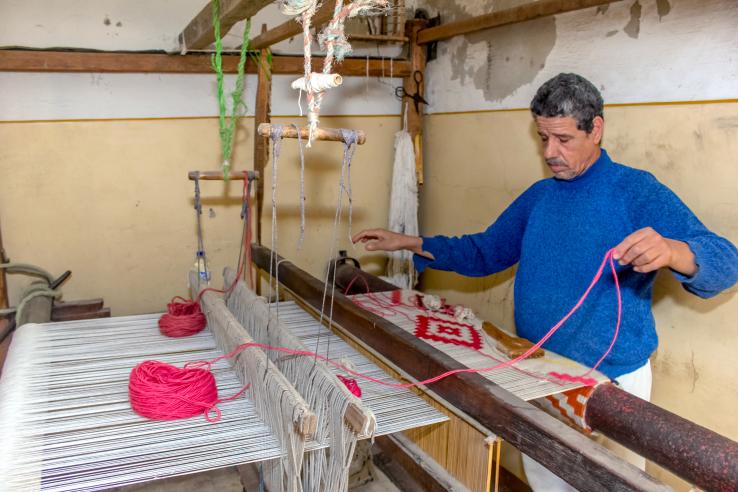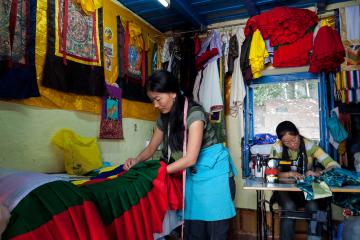
Egyptian rug firms weave their way into foreign markets

Small- and medium-sized enterprises (SMEs) often struggle to find foreign markets to export their goods. As such, in recent decades, governments, nonprofits, and donors have increasingly invested resources towards market access initiatives to help solve this problem. These initiatives aim to improve livelihoods for SME workers and promote exports by matching firms with foreign buyers.
In theory, access to high-income markets may help SMEs in low- and middle-income countries not only improve their profits but also promote “learning-by-exporting.” By repeatedly engaging with buyers in foreign markets, who often demand higher quality standards, firms can improve their technical skills and efficiency. However, evidence remains limited on whether “learning-by-exporting” occurs, and how access to export markets impacts SMEs.
In order to further explore this issue, from 2011 to 2014, J-PAL affiliates David Atkin and Adam Osman, with co-author Amit K. Khandelwal, evaluated small rug producers in Egypt to understand how exporting affects firms’ profits and productivity.
They partnered with Aid to Artisans (ATA), a United States-based nonprofit that aims to create economic opportunities for handicraft producers in low- and middle-income countries, and Hamis Carpets, the largest rug intermediary in Fowa, Egypt, to provide a random subset of rug firms in Fowa with the opportunity to export handmade carpets to high-income foreign markets.
Over the course of this three-year program, researchers periodically surveyed all firms to assess their productivity and knowledge flows between foreign buyers, Hamis Carpets, and local producers. A master artisan intermittently measured the quality of firms’ rugs along eleven dimensions, including touch, weight, firmness, and waviness. Researchers also measured rug quality in a structured setting; in 2014, they invited all firms to a rented workshop location and asked them to produce an identical rug using the same loom and inputs. Comparing these identical-specification rugs allowed researchers to compare changes in quality and productivity between exporting firms and comparison firms.
Based on this evaluation, Atkin, Khandelwal, and Osman reached the following key conclusions:
- Offering small firms the opportunity to export products increased profits. Exporting firms’ monthly profits increased by 26 percent relative to comparison firms. The effect of this market access initiative was large relative to other previous externally evaluated interventions targeted at firms, such as credit access and business training programs, which have had limited impacts on profits for similar firms.
- Providing export opportunities improved firms’ technical ability and efficiency in producing high-quality rugs. When a master artisan assessed rug quality on a scale from 1 (lowest quality) to 5 (highest quality), exporting firms scored 0.79 points higher than comparison firms, who scored 2.96 points on average. Moreover, when all firms were asked to prepare rugs with identical specifications using the same equipment, those offered export orders produced rugs of higher quality and in less time than comparison firms, suggesting improvements in efficiency.
- Improvements in quality were indeed a result of “learning-by-exporting.” While there were no immediate improvements in quality or productivity after the exporting intervention, significant improvements appeared after five months. This suggests that firms learned and adjusted their production practices as a result of engaging with buyers in foreign markets. In particular, evidence suggests that knowledge transfers between foreign buyers, Hamis Carpets, and local producers partly explained the eventual improvements in quality and efficiency.
Drawing from these key findings, it becomes evident that greater access to foreign markets may be more valuable than greater access to domestic markets for SME development.
This is largely the case for three reasons:
- Access to foreign, high-income markets exposes firms to sophisticated buyers who have higher quality standards than many domestic buyers;
- Such buyers are often willing to pay more for higher quality products; and
- These foreign buyers and their local intermediaries can be willing to help local producers improve overall quality by transferring knowledge gleaned from their experiences producing and selling high quality products.
In such cases, SMEs likely must strengthen their quality and learn from their buyers and competitors in order to meet the demands of high-income, foreign markets. This, in turn, can lead to greater quality, productivity, and profitability.
That being said, it is important to note that increasing low- and middle-income country SME access to export markets comes in different forms. This particular intervention in Fowa induced exporting by facilitating connections between local firms and sophisticated foreign buyers. Other interventions or policies that reduce barriers to exporting—including by reducing tariffs or other trade costs—may generate similar benefits for SMEs in low- and middle-income countries.
Market access programs may also complement more standard interventions such as microcredit access or business training programs. Recent research on other methods for supporting firms—such as credit access and business training—finds that these programs have limited impact on firm profits. Rather, coupling credit or business training with market access interventions may be an effective strategy for improving SME profits and growth.
To learn more about this evaluation and its related policy implications, read our new policy briefcase here.





